|
MOUNT RAINIER NATIONAL PARK NATURE NOTES
|
| Vol. XIV |
March - 1936 |
No. 1 |

Spore-bearing frond of the Deer Fern.
 |
Because of their beauty, abundance and inherent interest Mt. Rainier
Natl Park's ferns occupy an important place in its botany. They lend an
effect of almost tropical luxuriance, in places, to the forests of the
lower Canadian zone. They are, however, by no means limited to this
habitat. Some may be found growing in meager soils or in talus slopes.
Still others anchor themselves in small niches in moist, moss covered
rocks while others clothe the earth of open sunny places as in the case
of the braken which attempts to rehabilitate burned areas in the forests
of the Northwest. Nor is the interest in our fern flora limited to the
summer season for certain species are evergreen and may be noted
throughout the year.
The ferns belong to a group in the plant kingdom known as the
Pteridophytes (spore bearing plants having vascular structure and
possessed of true roots) which embraces some 6000 known species,
scattered throughout the world and varying in size and form from
hair-like creeping stems bearing a few simple moss-like leaves to tall
tree-like growths. Mt. Rainier Natl Park can claim but a small part of
this number as only 31 species are indigneous to this area. Fifteen of
these are included in such families as the horsetail, club moss,
quillwort and grape fern which have few outward fern characters.
The following descriptive key deals only with those of this division
(pteridophytes) which are commonly regarded as ferns. (Polypodiaceae)
Many of these are widely distributed throughout the west so an
understanding of Rainier's ferns will aid you in an acquaintance of your
own local plants of this type.
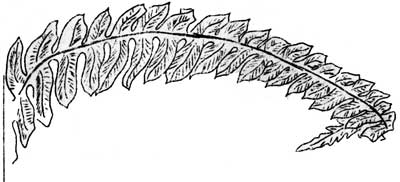
DEER FERN - "pinnae attached to stem along entire width" (sessile).
To identify a fern by means of a key of this type start with #1 on
the left side of the page, select the most likely of the two descriptive
paragraphs and refer to the number on the right which directs one to
another pair of descriptions. Thus by successive elimination one finally
arrives at the proper name of the plant in question.
-oOo-
| 1-Fronds distinctly of two kinds - vegetative and spore-bearing.
. . . . . . . . | 2 |
| 1-Fronds not distinctly of two kinds - spore bearing fronds the
same as non-spore bearing fronds . . . . | 3 |
2-Plant evergreen (except spore-bearing fronds). Vegetative fronds
2"-4" wide and 12"-24" long and arranged in a basal rosette tuft on the
ground; 1-compound, pinnae attached to stem along entire width
(sessile). Pinnae without indented or "saw-toothed" margins (entire).
Spore-bearing fronds up right, 16-40" long and 1"-3" wide with very
narrow pinnae, widely spaced on stem. Very common in moist, shaded
woods. (Struthiopteris spicant) DEER FERN.
2-Plant not evergreen; 6"-12" tall. Foliage much divided and "paisely
like" in appearance and fronds densely tufted. Spore bearing fronds
taller than non-spore bearing fronds with spores borne beneath margins
of the spore-bearing pinnae which are recurved or "doubled under". Grows
in rocks and generally dry soils. (Oryptogramma acrostichiodes)
ROCK BRAKE or PARSLEY FERN.
|
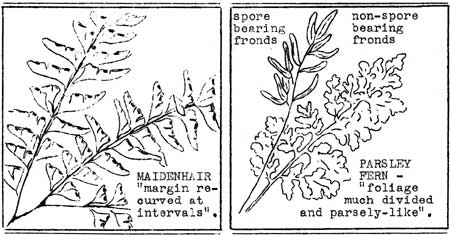
| 3-Spores borne beneath recurved or "doubled under" margins of
the pinnae . . . . . . . . . . . . . . . . . . . . . . | 4 |
| 3-Spores not beneath recurved margins of the pinnae; spore dots
plainly visible on underside of pinnae . . . | 6 |
4-Margin of pinnae recurved along its entire length. . . .
|
5 |
4-Margin recurved only at intervals. Plant rather delicate and
feathery in appearance; fronds loosely tufted; stems shiny and chestnut
brown. Pinnae attached to the stem by slender petioles; are thin,
delicate and deeply cleft on the upper edge. (Adiantum pedatum)
MAIDENHAIR FERN.
|
|
5-Plant stiff and coarse in appearance, not tufted. Fronds harsh and
brittle to the touch, usually 3 divided and having grey silky "fuzz" on
underside. Fronds 3-6 ft. tall with stem having a prominent groove along
its middle. Pinnules attached to stern along entire width (sessile) but
occasionally in case of larger ones they may be short stalked. In poorer
soils, common in open areas and in old burns. (Pteridium aquilinum
pubescens) BRAKE or BRAKEN.
5-Plant short, densely ted. Fronds 4"-14" long, 2 and sometimes 3
divided with underside of pinnae brown and "fuzzy". In dry rocky
situations - not common. (Cheilanthes gracillima) LACE
FERN.
|
|
6-Plant tufted. . . . . . . . . . . . . . . . . . . . . . | 7 |
| 6-Plant not tufted. . . . . . . . . . . . . . |
|
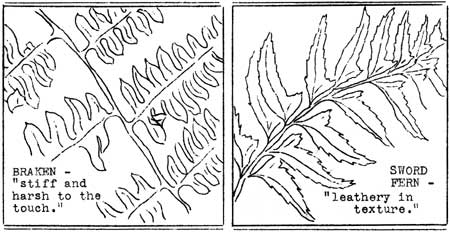
|
7-Fronds may be divided either once or twice with individual pinnae
edged with numerous sharp pointed sawedged teeth, with a large lobe on
upper side and joined to stem by a slender, short petiole. Fronds of
general leathery texture and ever green. Frond stalks covered at base
with numerous brown scales . . . . . | 8 |
| 7-Pinnae not sharply saw-toothed with pointed, conspicuously
barbed teeth or if "toothed" the teeth have a ragged rather than
distinctly saw edged character. . . . . | 10 |
8-Fronds only 1- compound . . .
| 9 |
8-pinnae at base of fronds divided a second time-two compound. Fronds
16"-40" long: widest between base and middle with pinnules sessile and
margined with numerous bristle-pointed teeth. (Polystichum
andersonii) BRISTLE or VANCOUVER FERN.
|
|
|
9-Fronds 6-24" long and 1"-3" wide at widest part which is just above
the middle. Pinnae holly-like in appearance and edged with large teeth
interspersed with teeth of smaller size. Evergreen. (Polystichum
andersonii) HOLLY FERN.
9-Fronds 12"-60" long, leathery i texture; 2 10" wide at widest point
which is between base and middle of its length. Pinnae long and linear;
1/4" wide and up to 3" long. Teeth of pinnae recurved. Evergreen. Very
common in deep woods. (Polystichum munitum) SWORD FERN.
|
10-Fronds very narrow - linear in outline; 1/3"-1" wide and 2"-10"
long; densely tufted and generally in bunches about as wide as tall.
Pinnae bright green oval or round in outline with wavy margins, square
at base and attached to stem by slender short stem (petiole). In cliffs
and rocky places above 5500'. Not common. (Asplenium viride)
SPLEENWORT.
10-Not as described above. Fronds not linear in outline and divided
more than once . . . . . . . . | 11 |
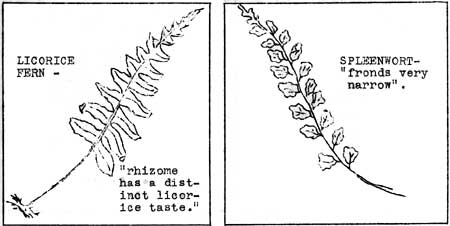
|
11-Plant small to medium in size. Fronds usually 5"-10" long but
sometimes as much as 24"; tufted but lossely so and spreading; divided
once or twice. Frond stalk very slender, fragile and straw-colored.
Quite common from deep woods to timberline. (Cystopteris
fragilis) BRITTLE FERN.
11-Plant generally larger than above.. Stems of fronds not delicate .
. . . . . . . | 12 |
12-Plant of Hudsonian zone (5000-6500') and common in rocks and talus
slopes. Fronds deep green, densely bunched and erect - this stiffly
erect character being very characteristic. Base of fronds grow from
beneath rocks. Fronds 8"-28" long and about 1-1/2"-5" wide at widest,
divided twice or three times. Leafstalk stout, curving from beneath
rocks, brown and having numerous brown scales at base. (Athyrium
alpestre var. americanum) ALPINE LADY FERN.
12-Plant of deep woods growing in moist rich soil of forest floor,
often along streams or boggy places. . . .
|
13 |
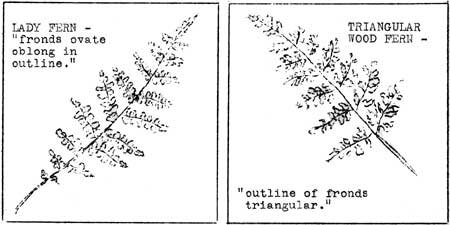
|
13-Fronds triangular in outline, longest pinnae at base of fronds.
Fronds divided twice or three times; 12"-40" long and 4"-6" wide at
widest point; tufted and wide spreading. Pinnules margined with rounded,
barbed teeth. One of most common of our deep woods ferns.
(Dryopteris spinulosa var. dilitata) WOODS FERN.
13-Fronds not triangular in outline, widest at or near middle of its
length and tapering toward both ends . . |
14 |
14-Very common in deep moist woods. Large and tufted and wide
spreading. Fronds generally 1-4 ft. long 2-3 divided. Margin of pinnules
with numerous ragged, rounded teeth. Leaf stalks short and covered at
base with numerous brown scales. (Athryium felix-femina)
LADY or SWAMP FERN.
14-Rather rare plant of deep woods. Fronds tufted 20-36" long and one
compound. Pinnae attached to stem along the entire width. Frond stalk
straw colored and scaly at base. (Dryopteris oregana) SIERRA
WATER FERN.
|
|
15-Plant small, growing on rocks, logs, trunks or trees, generally in
moist places. Individual fronds 3"-6" long divided only once with pinnae
attached to stem along entire width. Margin of pinnae having shallow
wavy teeth. Pinnae may be rounded or pointed at tip. Rootstalk has a
decided licorice taste. (Polypodium vulgare) LICORICE
FERN.
15-Native of deep woods and common on rich humus, decaying logs, etc.
Has delicate appearance. Fronds arise from creeping rootstalk and the
slender stalk bears aloft three triangular shaped pinnae which lie in a
horizontal plane 6"-l0" above the soil. Margin of pinnules wavy.
(Dryopteris linneana) OAK FERN.
|
C. Frank Brockman,
Park Naturalist.
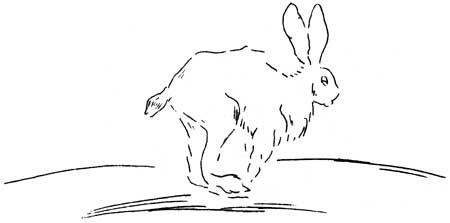
|

